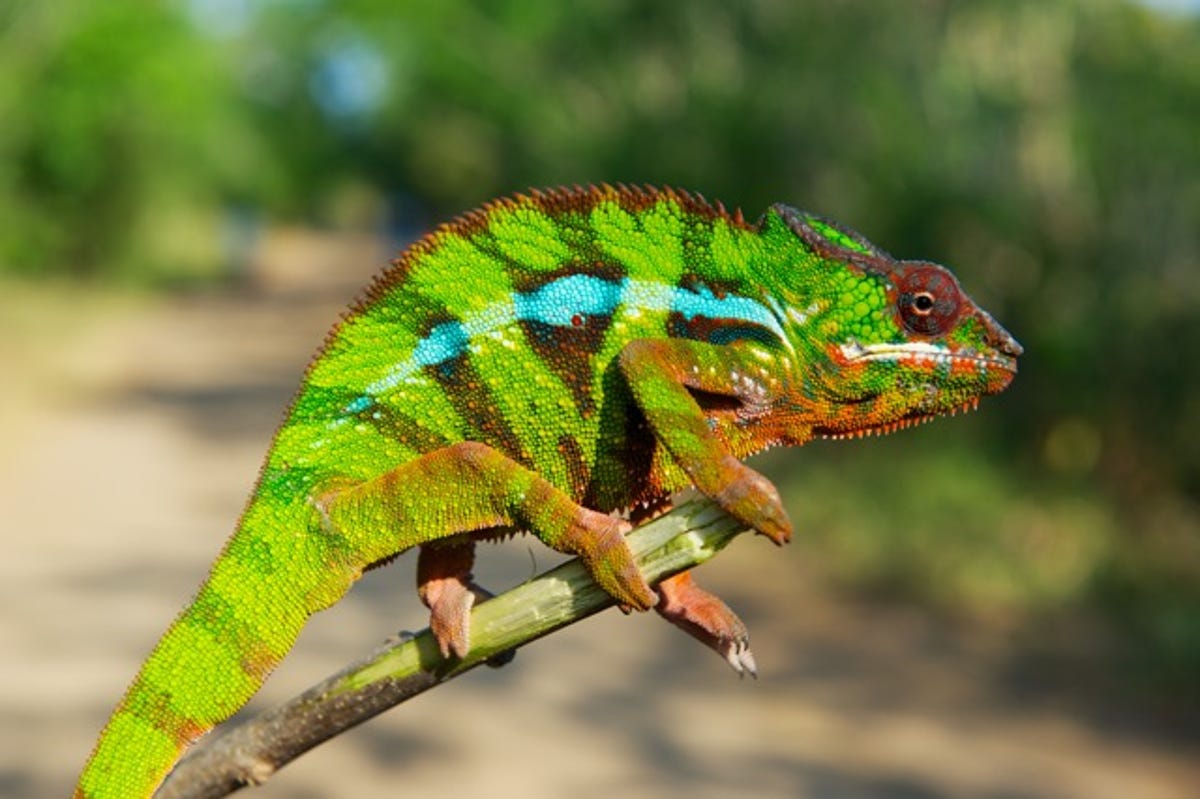The spectacularly colourful world of panther chameleons (pictures)
As it turns out, Madagascar's panther chameleons are not a single species, but 11 -- and their diversity is wondrous to behold.

The colour change mechanism in chameleons has only recently been revealed. It had previously been supposed that, like squids and octopuses, it was caused by organelles within pigment-changing cells called chromatophores.
Instead, as discovered by a team of researchers at the University of Geneva, the chameleon's ability to change the colour of its skin is thanks to a lattice of nanocrystals inside a thick layer of dermal iridophores, or iridescent chromatophores. See it in action here.
Chameleon feet, from a distance, look like they each only have two toes, which they use to grip branches. Get a little closer and you'll see something strange: one "toe" has three claws and the other has two. This is because each toe is actually a fused bundle of toes. On its forelimbs, the outer bundle contains two toes, and the inner bundle three; on the hindlimbs, the outer bundle has three toes and the inner bundle has two. Adorbs!
Chameleon eyes are unique among reptiles: the eyelids are fused, leaving only a hole just large enough for the pupils to peer through. The entire structure can pivot, giving the chameleon 360-degree vision around their bodies. Even more neat: each eye can move and see independently from the other, meaning that chameleons can look in two separate places at the same time. They use monocular depth cues, which provide depth information to a single eye, to locate prey.
Chameleons don't just use their gorgeous colours to hide among their environments. They use it for social purposes as well. Males, which are typically more elaborately coloured than females for this very reason, use their colours for courtship displays for the ladies, or for displays of aggression against other males or threats. Lighter colours are usually for wooing purposes, while darker colours are more intimidating. Males also typically have more ornamentation, such as horns and spikes.
Chameleons are exclusively "old world" lizards, found in Africa, Europe and Asia -- the parts of the world known to Europeans before contact with the Americas. Around half of the world's chameleon species are native to Madagascar, according to Wild Madagascar. The American chameleon, as it is called, is not a chameleon at all -- it's a different kind of lizard, the Carolina anole. It can still change colour, though.
Chameleons have very long tongues that they use to snag insects -- around 1.5 to two times the length of their bodies, although this proportion is greater in smaller chameleons. Powerful muscles in the chameleon's throat whip the tongue outwards at extremely high speeds -- 26 body lengths per second, or 21.6 kilometres (13.4 miles) per hour. The acceleration rate is phenomenal, from 0 to six metres (20 feet) per second in 20 milliseconds, a rate faster than muscles could achieve alone. A collagen structure in the mouth of the chameleon acts as a catapult; this is how it achieves such incredible acceleration.
Compared to other reptiles, chameleons have magnificent vision: they can see 5 to 10 metres away, all the better to see small prey with, my dear. Chameleons can also see in the ultraviolet spectrum, and they seem to thrive under ultraviolet light in captivity; eggs irradiated with ultraviolet light are more likely to hatch and produce living young, and the animals are more social. It's hypothesised that the UV irradiation helps compensate for a lack of vitamin D in captive environments.
There is a lot of size variation between chameleon species. The biggest is Madagascar's Malagasy giant chameleon, with a maximum length of 68.5cm (27 inches). The smallest is the teensy tiny Brookesia micra, which has a maximum length of 2.9cm (1.1 inches). Panther chameleons are somewhere in the middle, with a maximum length of around 50cm (20 inches).
Chameleons are not very social animals, coming together only to mate. Males will try to intimidate each other when they come into contact with other males; males and females will mate, unless the female is already gravid (that is, carrying fertilised eggs). When she is gravid, the female's colouring will change, darkening to signify to the male that she does not want to mate. Producing eggs takes a pretty heavy toll on the female's body -- she'll produce usually between five and eight clutches in her lifespan, which is two to three years. That's shorter than the male's five years because of those reproductive stresses.
Chameleons are not very good listeners. Maybe they want to be, but the fact is that they're physically incapable of it: all that ocular ability has a tradeoff, and that it's that the chameleon is hard of hearing. Chameleons don't have middle or outer ears, just small holes in their heads that can pick up sounds in the 200 to 600Hz range. (Humans are generally accepted to have a hearing range between 20 and 20,000Hz.) Instead, chameleons rely on sensing vibrations and their eyes to navigate the world around them.

